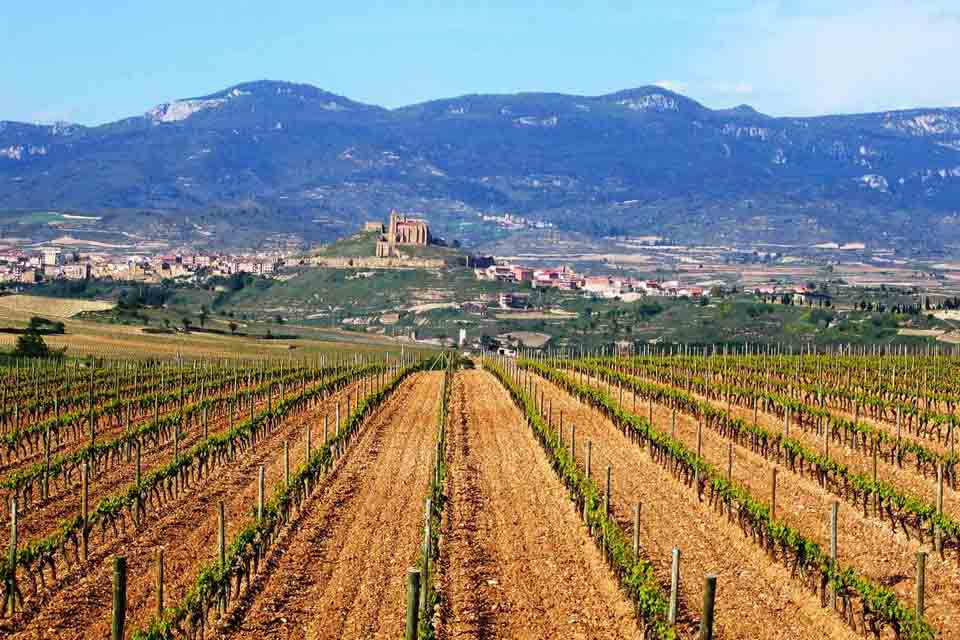
One afternoon many years ago, during a dismal grey November in London, I was driving around in Battersea close to the River Thames. Suddenly I spotted an oldish-looking wine shop that I’d not noticed before. It turned out to be a rather dusty, Dickensian sort of place, but among the clutter of bottles and wine cases, I found some old bottles of unusual Spanish white Rioja. Though the vintage seemed impossibly old, I bought a bottle, took it home and tasted it. The wine was a revelation: the aroma and mineral, nutty taste were sublime. If bottled Spanish sunshine were possible, this was it, or so it seemed at the time. The next morning, I sped back to the shop and bought their entire stock. This was not as cavalier an action as it might sound, because there were only six bottles left. But it started my love affair with Spanish wine.
Although my first taste of Rioja was a white one, eighty-six percent of all Rioja wines are red. They come from North Central Spain; about two hours’ drive south from the Basque city of Bilbao. The Rioja wine region lies in several fertile valleys along the Ebro River, protected from the Atlantic breezes by a jagged mountain range known as the Sierra de Cantabria. In his book Sherry and the Wines of Spain, George Rainbird describes the region as “one of the most beautiful wine growing areas in the world.” And incidentally, the name is pronounced as “REE-OCH-AH” in which the “OCH” sounds a bit like that in the Scottish word “loch”.
They’ve been making wine there for over a thousand years and the earliest written evidence of wine-making dates from the year 873. The reds are based on one of Spain’s national grapes, the Tempranillo, but they’re invariably blended with small quantities of other local grapes. The name “Tempranillo” comes from the Spanish word temprano (“early”), because it tends to ripen several weeks before the others.
Regardless of whether the wine is red or white, there are four types of Rioja, related to how long they have been aged. The requirements for reds and whites are slightly different, but we’ll just consider the reds here. Entry level wines are simply labelled Rioja and they’re young wines (sometimes known as Joven) that have no ageing requirements but enjoyed for their freshness. The next level up is Rioja Crianza. These are aged up to a year in the barrel and a few months in the bottle and at this level, some of the characteristics of Rioja appear.
The next level upwards is known as Reserva and they’re aged at least three years. It’s a more serious wine, with at least one year in the barrel. At the top of the tree, the Gran Reserva wines are aged for a minimum of five years but made only in exceptional years using the best-quality grapes. They often have a high sugar concentration and a more defined structure and sometimes aged much longer than the legal requirement.
Marqués de Cáceres Rioja Crianza 2016 (red), Spain (฿757 + VAT @ Vines to Vino, Pattaya)
Founded in the late 1960s, the Spanish wine producer Marqués de Cáceres has become one of the region’s most well-known companies. It produces a full range of Riojas and this is a typical Crianza made from blend of 85% Tempranillo, topped up with Garnacha Tinta and a dash of Graciano. The wine was matured for a year in French and American oak barrels and then aged in bottle for several months before going on sale. I first tasted this wine many years ago and was impressed with its sense of place. It reminded me of heavy dark wooden Spanish furniture in shaded rooms and the “slow old tunes of Spain,” to quote John Masefield.

To my mind, the 2016 vintage is more modern style and less “Spanish” than it used to be, but perhaps this reflects a general worldwide trend. The wine is a deep, rich red with an oaky aroma of cherry and blackberry with a touch of spiciness. It’s medium-bodied with a soft and velvety texture. At 13.5% ABV, there’s plenty of black fruit on the palate and a pleasing layer of soft, firm tannins. The wine has a satisfying long and balanced finish which is usually one of the hall-marks of a well-crafted wine, though be sure to serve it at a suitable temperature. The old-fashioned advice that you should “serve red wine at room temperature” is wrong because it implies that all red wines are the same, which is simply not true. Generally, young, light reds should be served at a lower temperature than richer older ones. In its home country, the light and fruity Beaujolais is served quite cold.
The best all-round advice for our topical climate would be to serve most ordinary reds at cellar temperature. This Rioja Crianza will be at its best at 16°-17°C (61°-62°F) which will feel “coolish” but definitely not “cold”. You can also enhance the aroma and taste by giving the wine air contact for about twenty minutes before tasting it. Believe me, it’s worth taking the trouble.
 |
 |
 |





